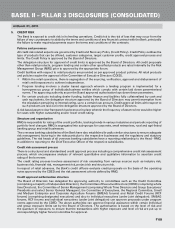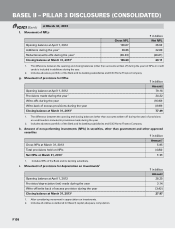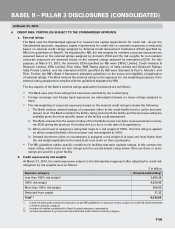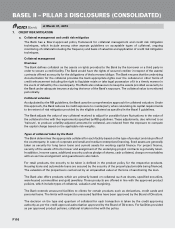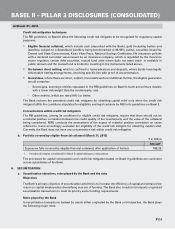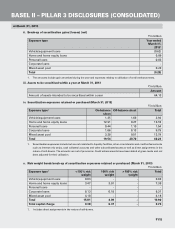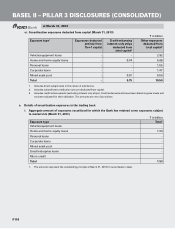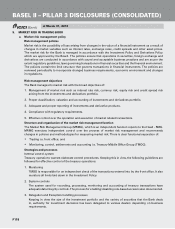ICICI Bank 2013 Annual Report Download - page 191
Download and view the complete annual report
Please find page 191 of the 2013 ICICI Bank annual report below. You can navigate through the pages in the report by either clicking on the pages listed below, or by using the keyword search tool below to find specific information within the annual report.
F113
• non-enforceability of security/claims due to imperfection in execution of the underlying facility
agreements with the borrower(s).
• Reputation risk: Risk arising on account of
i) rating downgrade of a securitised instrument due to unsatisfactory performance of the underlying
asset pool; and
ii) inappropriate practices followed by the collection and processing agent.
In addition to the above, securitised assets are exposed to prepayment and pipeline and warehousing risks.
Prepayment risk arises on account of prepayment of dues by obligors/borrowers in the assigned pool either
in part or full. Pipeline and warehousing risks refer to the event where originating banks are unable to off-load
assets, which were originated with an intention of selling thus potentially exposing them to losses arising
on declining values of these assets. The Bank does not follow the “originate to distribute” model in the
domestic market and hence is not exposed to the pipeline and warehousing risks in the domestic market. In
the overseas markets, where the Bank executes certain transactions on a “originate to distribute/syndicate”
model, the Bank has established an appropriate risk management and mitigation framework to assess and
manage any risks associated with such transactions.
Processes in place to monitor change in risks of securitisation exposures
The Bank has established appropriate risk management processes to monitor the risks on securitisation
exposures, which include:
i) Monitoring credit risk
The Bank in the capacity of collection and processing agent prepares monthly performance reports which
are circulated to investors/assignees/rating agencies. The securitised pools are continuously monitored
and those requiring attention are subjected to specific interventions (e.g. focused collection efforts in
affected geographies etc.) to improve their performance.
The risk assessment of the pools is done continuously by the rating agencies based on amortisation
level, collection efficiency, credit enhancement utilisation levels and credit cover available for balance
deal tenor.
ii) Monitoring market risk
The Bank ascertains market value of the securitisation exposures based on extant norms, which is
compared with their book value to assess the marked to market impact of these exposures monthly.
Bank’s policy governing the use of credit risk mitigation to mitigate the risks retained through securitisation
exposures
The Bank has not used credit risk mitigants to mitigate retained risks.
b. Summary of the Bank’s accounting policies for securitisation activities
Whether the transactions are treated as sales or financings
The Bank transfers commercial and consumer loans through securitisation transactions. The transferred
loans are de-recognised and gains/losses are accounted for only if the Bank surrenders the rights to benefits
specified in the underlying securitised loan contract. Recourse and servicing obligations are accounted for
net of provisions.
In accordance with the RBI guidelines for securitisation of standard assets, with effect from February 1, 2006,
the Bank accounts for any loss arising from securitisation immediately at the time of sale and the profit/
BASEL II – PILLAR 3 DISCLOSURES (CONSOLIDATED)
at March 31, 2013


